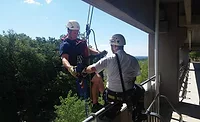Emergency Preparedness
Over forty years ago in the small Massachusetts town where I grew up, there was a fire that killed a crew of roofers. A friend of mine lost his father in that tragedy. A five-man crew was on a four-story roof applying tar and ballast when a sudden explosion erupted from the first floor automobile garage below. There was no second exit and no job ladders tall enough to reach the roof. The davit and well wheel used to hoist materials had slipped its rope and was too near the garage to be useful. Fed by the flammable liquids, the fire spread with amazing speed. In the time it took the volunteer fire department to respond, the roof was enveloped by an oily black smoke. When rescuers reached the roof minutes later, the deck was totally consumed and the construction workers lost. A later investigation suggested that most had died attempting to reach the ground by way of the stairs. The small town was stricken with a paralytic sadness. The comments I heard were all similar: It was a chilling tragedy because nothing could be done to save them. Today I’m not so sure.
The Emergency Action Plan
The General Health and Safety provisions of the OSHA standard (1926.35(a)) mandate that every employer develop site-specific emergency measures in the form of an Emergency Action Plan (EAP). These plans “shall cover those designated actions employers and employees must take to ensure employee safety from fire and other emergencies.” Likewise, the General Duty Clause in the OSH Act states that the employer shall “Provide a safe and healthful workplace” free from conditions and acts that may prove hazardous to employees at any time. The written EAP must be kept at the workplace and made available to all employees for regularly scheduled review and revision.The basic components of a written EAP for construction employers must minimally include:
1. A description of all emergency escape procedures and routes. Procedures should be specific to each work site and include alternate routes and areas to be avoided during particular emergencies (e.g., elevators in a fire). Alternate escape routes are less convenient evacuation paths often endowed with limited risks or controlled hazards (such as repel lines, aerial lifts, multiple staged portable ladders).
2. Any procedures to be followed by designated employees who may remain to operate necessary functions before evacuating themselves. These tasks may include deactivating operational equipment, securing hazardous materials, assisting in the evacuation of others, and providing critical first aid to the injured.
3. Procedures to initially and periodically account for all employees during and after emergency evacuation. Assign one or more employees to count heads and take roll call of various crews and sub-crews. Designate an evacuation assembly point. Have a procedure to relocate further to a safer location should the conditions worsen or the danger zone perimeter increase.
4. Specific emergency rescue and medical duties for those employees trained, equipped and designated (in writing) to perform them. At the least, have every job foreman trained in first aid and CPR. Extend training to include high and low-angle rope procedures for both self- and third-party rescues. When called for, train those employees who must work in hazmat areas for at least awareness-level Hazardous Waste Operations and Emergency Response.
5. Detailed and preferred means of reporting emergencies to the employer and emergency responders. List primary emergency response numbers for each location. Also, initiating a “phone tree” after the initial 911 call has been placed frees your foreman to deal with emergency scene management.
6. The names, positions and duties of designated in-house emergency personnel (Competent Persons), who will either respond specifically during an emergency or be responsible for the design, maintenance and overall implementation of the EAP.
7. The emergency alarm system(s) to be used on the construction site.
Like any other plans we make, an EAP is imperfect and meant to change. We make mistakes. We forget things. Don’t be afraid to change your EAP. Perform a random mock drill incorporating these changes. Make sure it really works. The plan should be made to be redesigned to fit your workplace and your workforce.
Leadership Means Letting Trouble Find You
Also consider that you should provide your employees with an immediate and suitable post-emergency corporate response. A genuine concern for the emotional health of stressed or injured surviving employees immediately and long after the smoke has cleared is extremely important to your firm’s future. Management’s leadership should be unquestioned and unlimited.Corporate Should Mean Responsible
As our nation’s recent horrific loss of life and property due to terrorism has cruelly illustrated, it is not always possible for an employer to protect his or her employees from all dangers and hazards, especially when criminally and maliciously plotted to destroy life. But to remain unprepared, even under unprecedented circumstances, is unacceptable.The responsibility for the life and safety of human beings at their place of work stops at the desk of the president, chairman or CEO. The most important feature of any EAP is the employer. His or her leadership must be clearly evident in every portion of emergency preparedness as well as emergency response. When designing your EAP, reestablish your corporate priorities. Place the physical and emotional well being of each of your employees ahead of your profit and market position.
In retrospect, almost all emergencies are, by definition, unimaginable. But whether caused by natural, accidental or manmade conditions, there is always something you can do to protect your employees. Back in 1956, there may have been little in the way of self-rescue equipment available to a roofer with only one means of access to his site. But a hundred feet of 3/4-inch manila rope soaking in a water bucket and leather gloves could have made all the difference to those men.
Today’s market is full of emergency safety devices. There are emergency escape respirators and smoke hoods, quick-donning mylar escape blankets and ponchos, kevlar escape harnesses, ropes, and emergency descenders. Even the widespread availability of aerial lifts up to 120 feet in the rental market makes rescue from an entrapping location a relatively easy event. No cost is too excessive if a life is spared. If you can prepare for your employees’ well being in almost any emergency with the conviction that being unprepared would be unconscionable, then your Emergency Action Plan and simulated rescue drills will be an example of corporate responsibility you can be proud of.
Make a commitment today to write a plan. Start off simply and build your EAP one job at a time. Deputize all of your workers, utilize all of their skills, encourage their input and before you know it, you’re miles down the road to saving lives and losses to those who matter most – your workers.
Looking for a reprint of this article?
From high-res PDFs to custom plaques, order your copy today!



